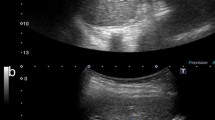Abstract
Intracystic papillary neoplasm (ICPN) of gallbladder is a comparatively new concept and is described as pre-malignant lesions in Nakanuma et al. (In: Bosman et al. (eds) WHO Classification of Tumours of the Digestive System, World Health Organization of Tumours, IARC, Lyon, 2010). ICPN with high-grade intraepithelial neoplasia is understood to include intraepithelial carcinoma or noninvasive carcinoma. And lesions with invasive cancer components are classified as ICPN with an associated invasive carcinoma [1]. According to Adsay et al., more than half of patients diagnosed with ICPN have invasive cancer components (Adsay et al., Am J Surg Pathol 36:1279–1301, 2012).
Polypoid masses in the gallbladder including benign, malignant, and non-neoplastic lesions have been called gallbladder polyps, and ICPN is also a polypoid lesion in the gallbladder. However, it is difficult to differentiate between them. In the literature, it is said that the possibility of malignancy is high in lesions exceeding 1 cm (Terzi et al., Surgery 127:622–627, 2000). And there are few reports on characteristic imaging findings of ICPN.
We have experienced three cases (two females and one male) of ICPN and report our imaging findings. Contrast-enhanced computed tomography revealed large papillary polypoid lesions approximately 2–4 cm in size in the gallbladder. Findings suggestive of deformation of the gallbladder wall and extrinsic progression were absent in all cases. T2-weighted magnetic resonance imaging revealed intense signals and diffusion-weighted imaging showed high intensity. Expanding of the gallbladder was seen in case 1, and a tumor stalk-like appearance was seen in the papillary mass in cases 2 and 3. Surgery was performed in all three cases and ICPN was diagnosed pathologically. The cancer was localized to the mucosa, with no infiltration of surrounding tissue in all three cases.



Similar content being viewed by others
References
Nakanuma Y, Curabo MP, Franceschi S (2010) Intrahepatic cholangiocarcinoma. In: Bosman FT, Carneiro F, Hruban RH, et al. (eds) WHO Classification of Tumours of the Digestive System; World Health Organization of Tumours, 4th edn. Lyon: IARC, pp 217–224
Adsay V, Jang KT, Roa JC (2012) Intracholecystic papillary-tubular neoplasms (ICPN) of the gallbladder (neoplastic polyps, adenomas, and papillary neoplasms that are ≥ 1.0 cm): clinicopathologic and immunohistochemical analysis of 123 cases. Am J Surg Pathol 36:1279–1301
Terzi C, Sökmen S, Seçkin S (2000) Polypoid lesions of the gallbladder: report of 100 cases with special reference to operative indications. Surgery 127:622–627
Zen Y, Sasaki M, Fujii T (2006) Different expression patterns of mucin core proteins and cytokeratins during intrahepatic cholangiocarcinogenesis from biliary intraepithelial neoplasia and intraductal papillary neoplasm if the bile duct—an immunohistochemical study of 110 cases of hepatolithiasis. J Hepatol 44:350–358
Sato H, Sato Y, Harada K (2013) Metachronous intracystic and intraductal papillary neoplasms of the biliary tree. World J Gastroenterol 19:6125–6126
Hashimoto S, Horaguchi J, Fujita N (2014) Intracholecystic papillary-tubular neoplasm of the gallbladder presenting with jaundice. Intern Med 53:2313–2317
Sato R, Ando T, Tateno H (2016) Intracystic papillary neoplasm with an associated mucinous adenocarcinoma arising in Rokitansky–Aschoff sinus of the gallbladder. Surg Case Rep 2:62
Rocha FG, Lee H, Katabi N (2012) Intraductal papillary neoplasm of the bile duct: a biliary equivalent to intraductal papillary mucinous neoplasm of the pancreas? Hepatology 56:1352–1360
Tanaka M, Fernandez-del CC, Adsay V (2012) International consensus guidelines 2012 for the management of IPMN and MCN of the pancreas. Pancreatology 12:183–197
Bennett S, Marginean EC, Paquin-Gobeil M (2015) Clinical and pathological features of intraductal papillary neoplasm of the biliary tract and gallbladder. HPB 17:811–818
Author information
Authors and Affiliations
Corresponding author
Ethics declarations
Conflict of interest
All authors declare that they have no conflict of interest.
Ethical approval
All procedures performed in studies involving human participants were in accordance with the Ethical Standards of the Institutional and National Research Committee and with the 1964 Helsinki Declaration and its later amendments or comparable ethical standards.
Informed consent
Informed consent was obtained from all individual participants included in the study.
Rights and permissions
About this article
Cite this article
Mizobuchi, N., Munechika, J., Takeyama, N. et al. Three cases of intracystic papillary neoplasm of gallbladder. Abdom Radiol 43, 1535–1539 (2018). https://doi.org/10.1007/s00261-018-1595-z
Published:
Issue Date:
DOI: https://doi.org/10.1007/s00261-018-1595-z




